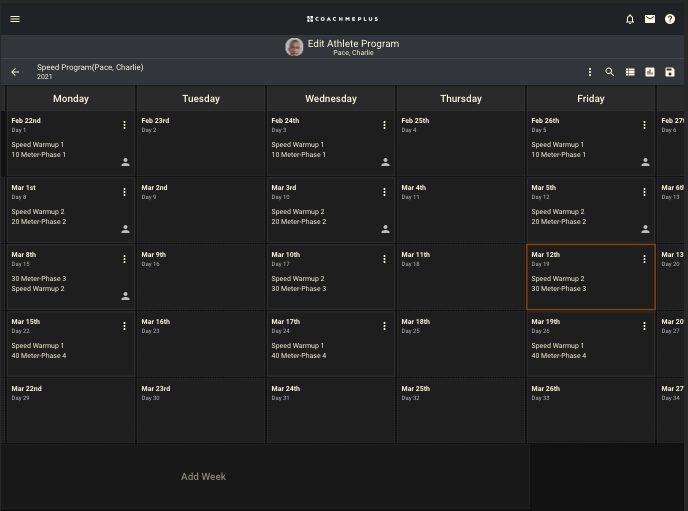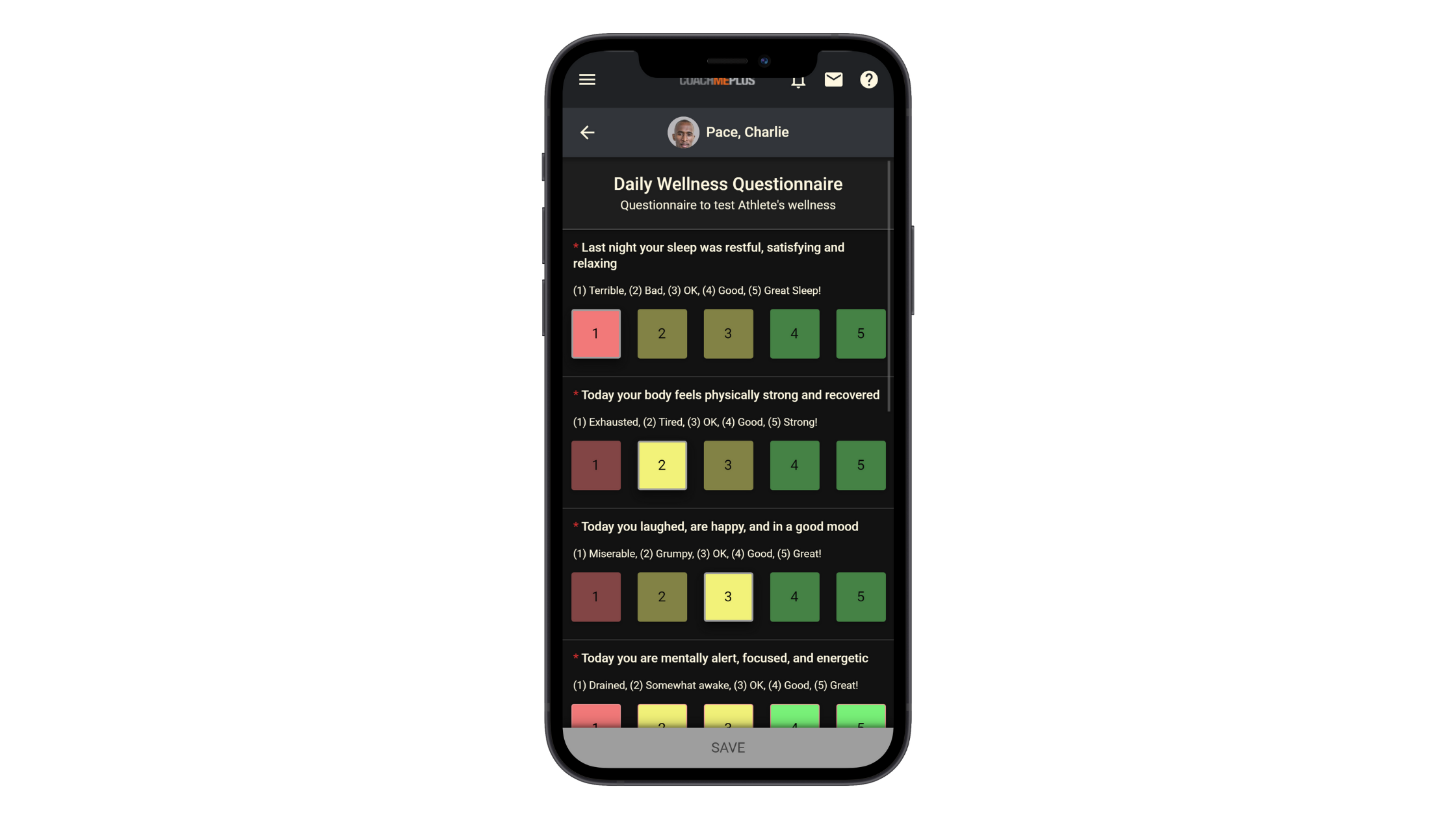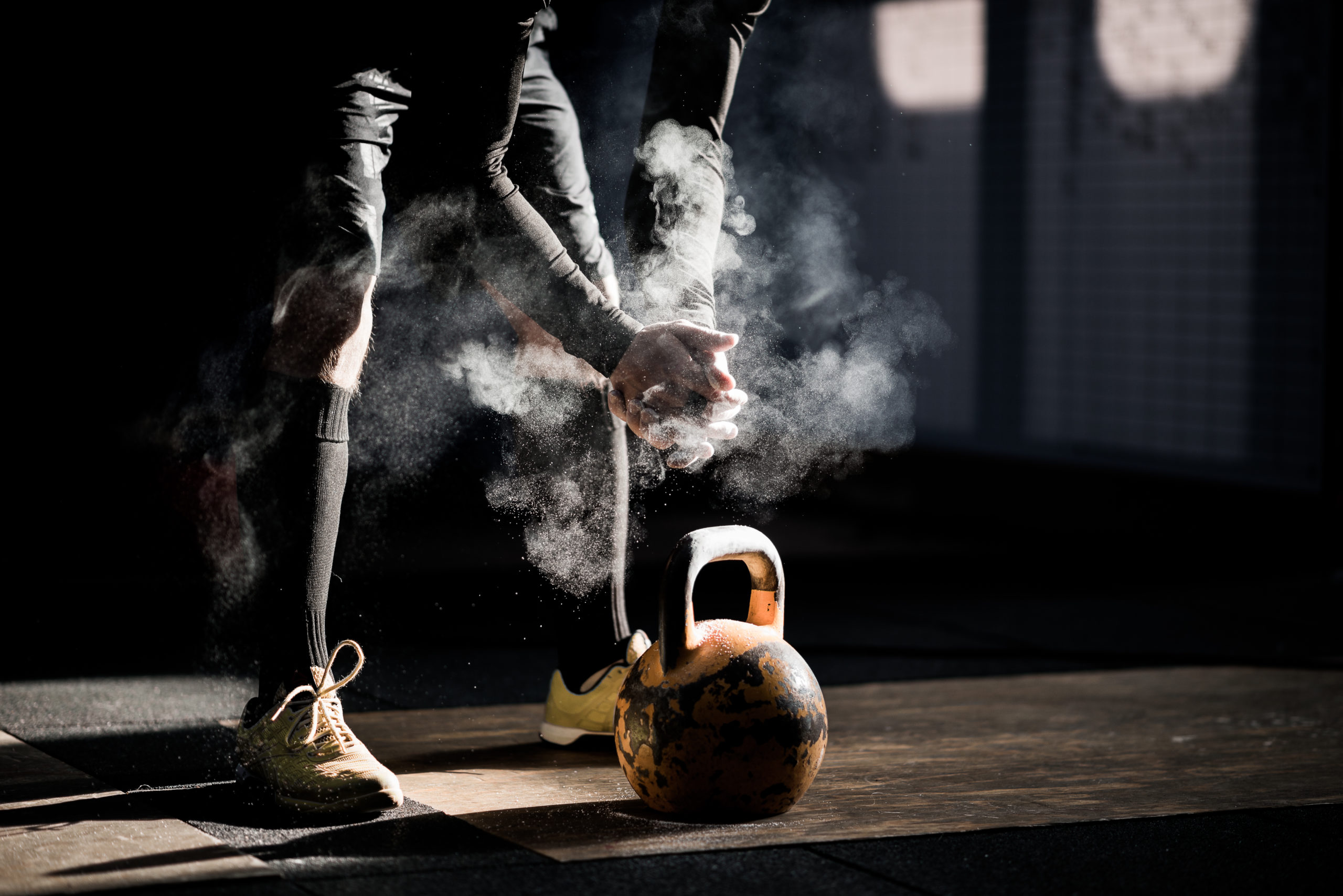There are three areas that need to be understood and managed appropriately during the competitive season which, if not done properly, can ruin the work done in the off-season. These areas are support staff, schedule structure, and key performance indicators. When the support staff is working well together and the schedule is structured to optimize performance, the key performance indicators will be expressed in safe zones without needing heavy-handed work to push them back to an ideal range. Proactivity on the front end can help us manage output.
ATHLETE TRAINING & RECOVERY CALENDAR

CoachMePlus Calendar View shows athlete training days and recovery days.
SUPPORT STAFF
At the NCAA level the support staff is working behind the scenes in a variety of functions including, but not limited to, strength and conditioning, sports medicine, mental health, equipment services, academics, compliance, performance nutrition, or sports science. These areas must find a way to work together as their responsibilities are tightly interwoven. When done effectively there is a seamless transition between services. In other situations, support staff relationships are so fractured that the group cannot function effectively to the detriment of the student-athlete. The easiest way to prevent this is for us to get our head out of the sand and help others.
Collaboration is key and regardless of direct responsibilities we must communicate with all departments in a manner where the athlete’s health takes priority. Issues are rarely a one domain problem. When done efficiently injury reports, GPS/wellness data, and academic aspects can be incorporated into weekly support staff meetings where all athletes are discussed. In this way, all parties have an opportunity to hear the issues that may be affecting a respective athlete.
Support staff collaboration builds relationships and these stronger ties help us put our egos in the background. Part of this collaboration can also occur with Mother Nature. Oftentimes we think we are a bigger part of the process than what is actually the case. It makes us feel good to see the athletes perform well and helps our ego when we feel like we are a part of the process. However, sometimes the biggest part of our job is to simply align the body in a way so that the natural processes biology has perfected for thousands of years can do the work we thought we were doing. Simply put, our work allows Mother Nature to do her job, such as chiropractic work, massage, or even rhythmic aerobic exercise for a sympathetically driven sport.
Sometimes Mother Nature can’t overcome the stressors applied. Looking at injury, loading, and wellness data over time, I’ve started to categorize causes and typically these events pop up disguised as a freak load an athlete wasn’t prepared for, a freak occurrence for which they could not have been prepared, or a previous load from which they did not recover before additional stress was applied.

As support staff, what can we do to organize the week and/or stressors to help mitigate these risks and align eustress and distress to make a more resilient athlete? If you look at the roster as an organism, it is probably 70% of the way recovered within the first hour or two post competition. The problem is the key athletes who played the majority of the game are REALLY pulling that average down. If we know this, we put can modalities in place to assist our contributors who are carrying the majority of the workload.
The bottom line is that work is more expensive when the battery isn’t fully charged. All activity damages the body and those with higher intensity create more damage. From a physiological standpoint, muscle takes the biggest beating but recovers the fastest, tendons/ligaments come in second place and bones are third. Depending on the severity of stress the CNS can take 24-72 hours to get back to baseline. Taking these constraints into consideration is a critical aspect of planning out the week’s regiment.
When volume, density and intensity are managed correctly, Mother Nature will do most of the work for us. However, this isn’t as simple as backing off on workload. While a decreased load may help us physiologically, it could be detrimental to our readiness from a tactical standpoint. In other words, the safest thing to do is to take a break from practice (hard for athletes to get hurt if they don’t get reps), but this likely prevents these same individuals from being effective when it comes time to perform. We need to give the athletes the reps they require to be effective in competition, which may not align with the number of reps the need to optimize recovery. The art of coaching lies in the ability to have discretion when blending science with intuition, without hiding behind either one.
ATHLETE WELLNESS QUESTIONNAIRES

Athlete Questionnaires collect critical information on athlete stress, sleep, and soreness. Athlete Dashboard visualize that information for training interventions
SCHEDULE STRUCTURE
Depending on the philosophy of the sports coaches, there is a variety of means to manage the workload. Strategic practice scheduling and structure is the most straightforward way to affect the majority of the roster as regardless of position, as every athlete will be affected by it. From a football standpoint, one example would be stacking the physical work towards the middle/late portion of the week (ex: Sunday or Monday off, nothing padded until Tuesday). This allows the support staff to attack the first 48 hours post-game with regeneration and physical preparation by giving more time on the front end for full recovery from the game without having to structure around practice – movement is medicine.
It may seem contrarian, but despite stiffness and soreness low-intensity movement is typically more beneficial than complete inactivity. As mentioned above, an emptier tank has a higher cost of doing business (supply and demand). If less speed/power/strength is available, they are more expensive to generate, which leads to increased injury risk. This schedule also increases the likelihood of a fuller practice roster spreading the workload more evenly amongst the entire team. Additionally, this gives more time on the front of the week to focus on academics, which has the potential to leave more bandwidth for the athlete to focus on the competition later in the week. Lastly, if Sunday is the day off, it gives the players a day during the week where they have nothing athletic or academically required and more time to spend with family if/when they are in town.
Conversely, workloads could be scheduled to primarily early/middle week (ex: first padded practice on Monday, with a Wednesday or Thursday off). While requiring a more coordinated effort from a scheduling standpoint early in the week due to a heavier load than the scenario above, this schedule does allow the support staff to work heavily during the final 48-72 hours pre-competition to make sure everything is properly aligned heading into competition. By consolidating the stressors into 3 out of 4 days in a row (Sat, Mon, Tues) it gives 3 days prior to the game to allow the body to prep. This also gives a mental break mid-week and an extra day for CNS readiness. Academically, workloads could be rearranged to later in the week, helping athletes who may be exhausted early in the week from the physical load over the weekend. One of the hardest parts of this type of schedule is overcoming our paranoia as coaches. We must trust our training early in the week and not let our obsession over preparation lead us into adding things late in the week and overwhelm the athlete with late week adjustments.
Both scenarios could be argued for and, depending on the level of competition within the calendar, both could be put to use during the same competitive season. It really comes down to what is needed at a given time. Communication is key throughout the organization to help ensure the best decisions are made.
HIGH STRENGTH DAY

KEY PERFORMANCE INDICATORS (KPI’S)
Collaboration with the support staff and strategic scheduling can help with the management of the majority of the roster. However, there is a critical group of athletes on every team that requires extra focus and work due to the significance of their role. For this group, it is imperative that the key performance indicators (KPIs) are identified for these individuals to best help mitigate the risk and stress to help ensure season-long availability.
In my experience speed, soreness, and mood are interwoven. They should take priority as KPIs from a monitoring and management standpoint because they drive adaptation throughout the organism and, when managed properly, can maximize performance. Over the years I’ve noticed that when soreness is increased, speed will be pulled down with it. When speed was down, we were not as successful during competitive play. Soreness also has been shown in our data to negatively affect sleep quality/quantity which is the cheapest and easiest thing to improve from a recovery standpoint.

Here are additional notes for these metrics:
- Speed
- An individual’s max velocity should ideally have been achieved every 7-10 days. If not achieved, there is an increased risk of injuries or decrements in the ability to express this quality.
- Variance in the expression of this quality can also be related to Xs and Os. Dig into the data and game film before making judgement.
- Questions to consider:
- How can you measure whether this is being reached?
- How can you build this into practice/training if it’s not achieved organically in the field of play during competition?
- Mood
- Athletes who are in a better mood will practice harder and perceive that effort to be less taxing.
- Better mood may also lead to things such as installing game plans or meetings that are less stressful on the coaching staff.
- Questions to consider:
- How can you measure an athlete’s mood?
- How can you affect an athlete’s environment to have a positive effect on their mood? Or frame the context of their performance to help ensure a consistent drive for performance?
- Soreness
- This quality will affect strength, power, and speed outputs in addition to mood. To reiterate what is mentioned above, soreness can also hurt sleep quality/quantity which would create its own unique problems.
- Questions to consider:
- How can an athlete manage their own soreness?
- How can you manage an athlete’s soreness?
- What are some factors that can fly under the radar which may also lead to soreness?
Sleep and nutritional choices can have huge effects. Here is a cycle that we have noticed through gathering wellness data in our athletes. The converse holds true as well. The hardest part with KPIs is knowing where to start and when to stop. My recommendation is to start with a few and really dig in. Going a mile deep with a few metrics that can be consistently and accurately gathered will likely provide more insight than the mile wide and inch deep approach.
RATING OF PERCEIVED EXERTION DASHBOARD

RPE Dashboard shows deviations in athlete’s reported exertion.
WRAPPING UP
Finally, it is important to point out that our own self-care needs to be a critical part of this process. We cannot consistently take care of others if we don’t take care of ourselves. This can mean a lot of different things to different people,such as sneaking in times to train, run, meditate, etc. We can get so caught up in the rat race of trying to fix others’ problems that we become action junkies burning ourselves out in a never-ending search for problems to solve. Embracing the atypical schedule of in-season can be a boost. For example, we may not get as much time with our family as others but we can completely control the quality of this time. Also, we can embrace and highlight the exclusive opportunities our family does have with events such as gameday attendance, post-competition gatherings, post-season competitions (regionals, bowl trips, March Madness, etc.) and–for those with kids–the unique experience of getting to hang out with college athletes. Find time to work on your own regeneration and recovery in-season, because when the competitive season is over, that is when the job of the support staff really swings into action and we must be ready to build next year’s team.

Recent Comments